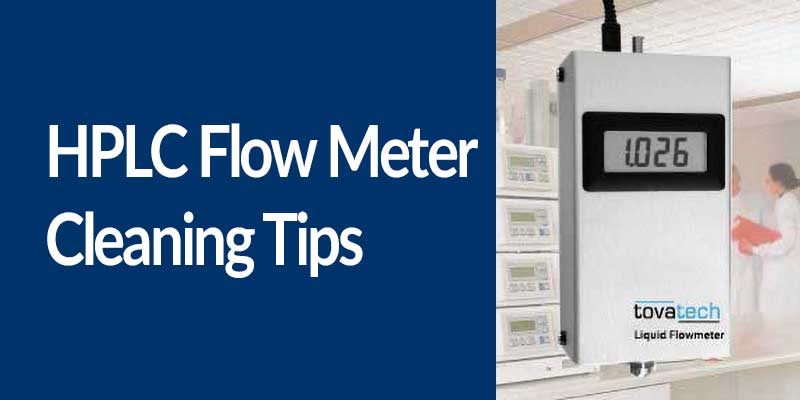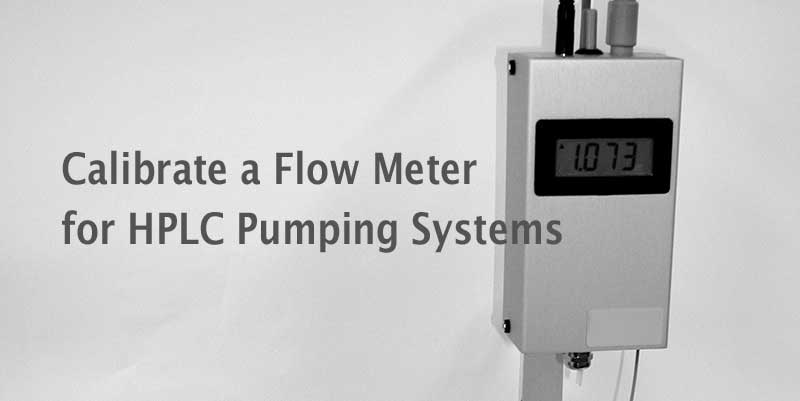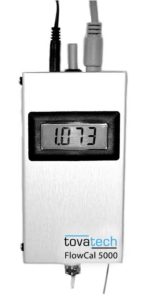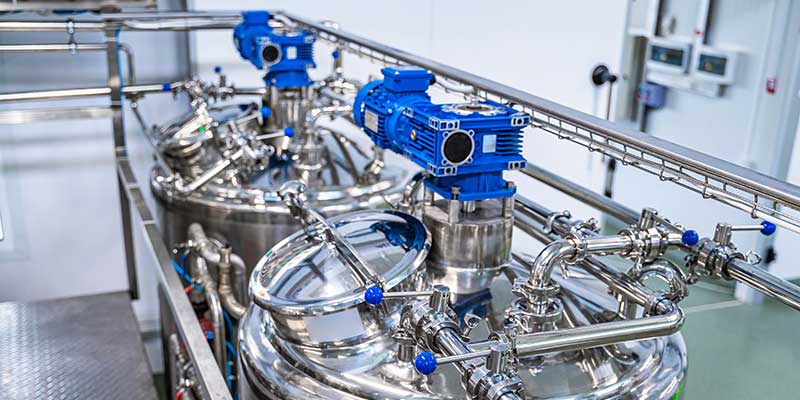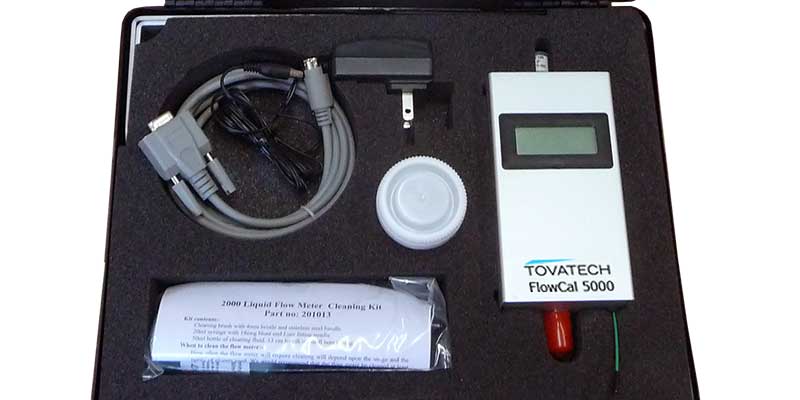HPLC Flow Meter
HPLC Flow Meter Cleaning Tips
Digital high performance liquid chromatography (HPLC) flow meters measure the accuracy of HPLC pumping systems to meet FDA and other regulations for equipment used in the pharmaceutical, biopharmaceutical and other analytical labs. Maintaining digital HPLC flow meters is a part of good laboratory practices.
High Performance Liquid Chromatography Market Growth
According to a report by Verified Market Research, “The High Performance Liquid Chromatography Market size was valued at USD 5,335.31 Million in 2022 and is projected to reach USD 8,084.56 Million by 2030, growing at a CAGR of 5.57% from 2023 to 2030.”
The report states the HPLC market “is anticipated to develop throughout the forecasted period as a result of the increasing usage of liquid chromatography equipment in forensic science, life sciences, and the pharmaceutical industry.”
What Do Digital HPLC Flow Meters Do?
Skip this if you already know.
Digital flow meters for HPLC pump systems measure rates … Read the rest
Flow Meter Calibration for HPLC Pumping Systems
Calibrating digital liquid flow meters that test high performance liquid chromatography (HPLC) pumping systems is performed prior to units being put into service. In accordance with GLP and to comply with other regulations, flow meter calibration – recalibration – should be performed annually. Digital HPLC flow meter recalibration is an exacting procedure requiring experts using high-precision measuring instruments. We describe it in this post after a brief explanation on
What Flow Meters Meter
As the name implies, flow meters measure the rate of flow of a product, usually through a pipeline or processing line. Gasoline pump flow meters at your local filling station are another common example. Standards may apply to periodic certification by calibrating flow meters to confirm that you are getting the fuel you pay for. Heating oil, natural or propane gas are also delivered via flow meters that vendors use to calculate your bill.
As another example, … Read the rest
IQ, OQ, PQ Examples for Analytical Instruments
Analytical instruments confirm processing equipment used in the pharmaceutical, food and other industries meet standards set by the FDA, the Code of Federal Regulations Title 21 and other regulatory bodies. Standards apply from the very beginning with design qualification. At the customer location equipment is validated and verified via initial and ongoing tests described in this post as IQ, OQ, PQ examples.
IQ, OQ, PQ Examples Defined
In brief IQ, OQ and PQ mean Installation Qualification, Operational Qualification and Performance (or Process) Qualification . An example is an HPLC system, including its pumps. These systems must precisely and accurately analyze pharmaceutical compounds as they proceed from R&D into manufacturing. We’ll go into that in more detail later.
But first, some more detail on our IQ, OQ, PQ Examples
Installation Qualification Described
As described in an FDA Group blog post “Newly installed or modified equipment must first be validated to … Read the rest
Digital HPLC Flowmeters – An Overview
What you’ll learn in this digital HPLC flowmeters overview:
- What flow meters do
- Flow measurement validation options
- HPLC flow meter calibration
- Mounting options for HPLC flow meters
- Connecting the flow meter to a PC
- How to maintain an HPLC flowmeter
- User testimonials
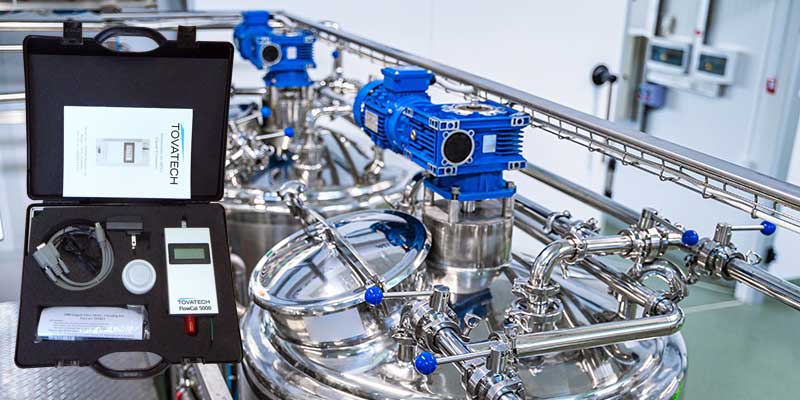
Flow meters come in many sizes and find application in a wide range of industries. As examples they meter gasoline pumped into your car and fuel oil into your heating system’s tank. But instead of metering in gallons (for example) digital HPLC Flowmeters measure small flow rates such as 0.05 to 25 milliliters (mL) per minute. This post provides an overview of lightweight, portable, and exceedingly accurate digital High Performance Liquid Chromatography (HPLC) flowmeters.
What HPLC Flow Meters Do
Among functions performed by HPLC are included checks for purity, monitoring changes in pharmaceutical intermediates during chemical synthesis scale-up, stability and dissolution tests, and performing ongoing quality control procedures.… Read the rest
How a HPLC Digital Flow Meter Works
Before explaining how a HPLC digital flow meter works here’s an explanation of what digital flow meters do:
Digital flowmeters performing high performance liquid chromatography are used to measure the accuracy of HPLC pumping systems in order to meet FDA and other regulations regarding installation qualification (IQ), operational qualification (OQ) and performance qualification (PQ) of equipment used in the pharmaceutical and biopharmaceutical industries as well as other analytical labs.
The process demands accurate, reproducible column retention time as an analyte (what is being analyzed) is pumped through the HPLC system.
These precision digital flow meters are not to be likened to flow meters used on process lines measuring flow rates in, for example, thousands of gallons per minute but instead in fractions of milliliters per minute. … Read the rest
How to Check Pump System Accuracy for HPLC Analysis
Pump system accuracy is crucial for equipment used to conduct high performance liquid chromatography (HPLC) analysis in the pharmaceutical and other industries subject to regulatory oversight by the FDA and similar authorities. Among functions performed by HPLC are included checks for purity, monitoring changes in pharmaceutical intermediates during chemical synthesis scale-up, stability and dissolution tests, and performing ongoing quality control procedures.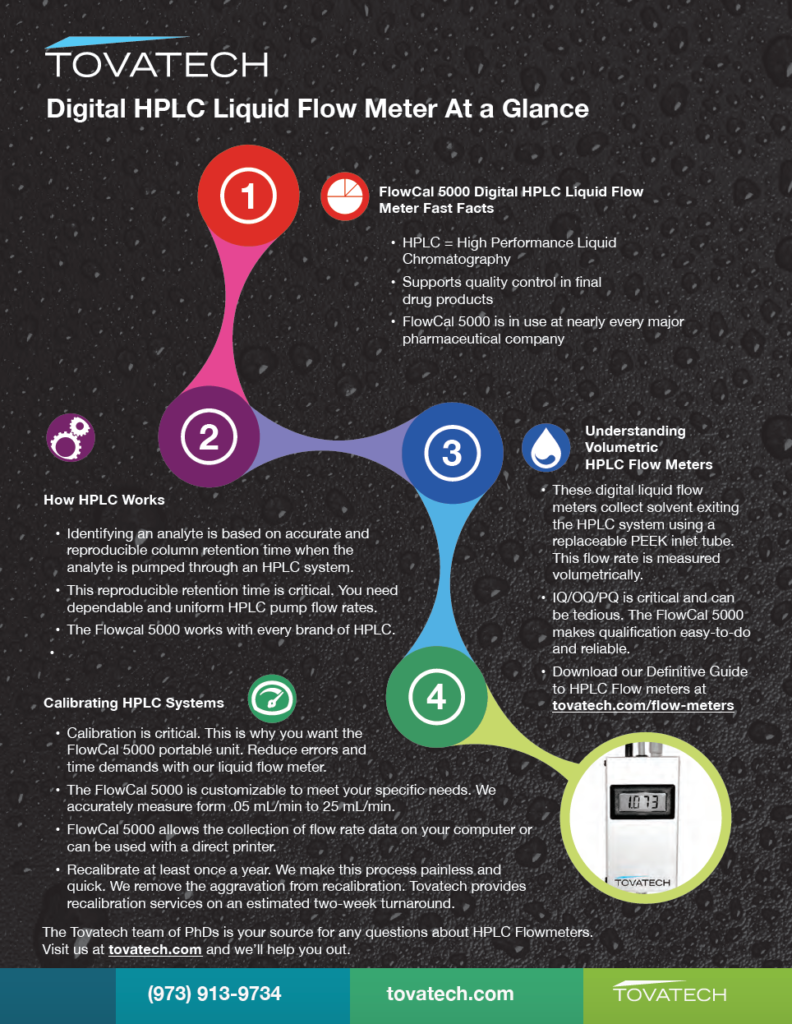 Click to download PDF
Click to download PDF
A Brief on HPLC Analysis
Identifying an analyte by HPLC is based on accurate and reproducible column retention time as the analyte is pumped through an HPLC system. Reproducible retention time is critical and depends on accurate, uniform, reproducible HPLC pump flow rates.
Note that it is important to distinguish between accuracy and precision. These two terms may seem the same but they are not necessarily so. For example, an HPLC system (or for that matter many other systems such as analytical scales) may … Read the rest
Digital HPLC Flowmeter Accuracy Checks
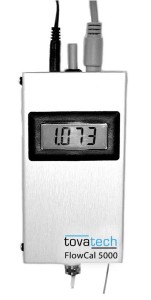 As pointed out in our post on HPLC pump accuracy uniform and reproducible column retention times are critical when analytes are pumped through a high performance liquid chromatography system. One of the most efficient ways of checking on the accuracy of HPLC pump systems is the Flow Cal 5000 digital liquid flow meter available from Tovatech. But how do you check on the accuracy of the checker – namely the Flow Cal 5000?
As pointed out in our post on HPLC pump accuracy uniform and reproducible column retention times are critical when analytes are pumped through a high performance liquid chromatography system. One of the most efficient ways of checking on the accuracy of HPLC pump systems is the Flow Cal 5000 digital liquid flow meter available from Tovatech. But how do you check on the accuracy of the checker – namely the Flow Cal 5000?
Flow Cal 5000 HPLC Flow Meter Accuracy Checks
When received from Tovatech the Flow Cal 5000 is accompanied by a UKAS traceable calibration certificate* good for one year. Standard calibration is 1 ml/min but on request it can be supplied at points from 0.5 to 25 ml/min. Multiple readings are taken at each flow rate then averaged on the calibration certificate.
A recalibration procedure should be scheduled annually or immediately if users think the unit is not … Read the rest
How Accurate is your HPLC Pump?
As researchers know a critical if not the most critical aspect of an HPLC pump system is providing uniform and reproducible column retention times as analytes are pumped through a liquid chromatography system. This in turn relies on uniform and reproducible HPLC pump flow rates. After initial operational qualification (OQ) periodic calibration checks of HPLC pump systems must be undertaken to confirm OQ and to identify and correct flow rate variances that may develop due to factors such as worn pump seals or sediments that interfere with flow rates. These calibration tests are performed by checking flow rates while pumping solvent through the HPLC system.
HPLC Troubleshooting – the Hard Way and Easy Way
Several of our posts on the FlowCal 5000 digital liquid flow meter explain how the system works in comparison to manual methods. Taking a paragraph from our Flow Meter Buyers Guide researchers “can measure flow rates … Read the rest
A Primer on HPLC Flowmeters
High performance liquid chromatography – HPLC – is very often the method of choice for analyzing pharmaceutical compounds starting with R&D and continuing into manufacturing. Among other things it is used to
- Check candidate drugs for purity
- Monitor changes in pharmaceutical intermediates during chemical synthesis scale up
- Test the stability and dissolution of formulations in development and
- Support quality control in final drug products
Identifying an analyte by HPLC is based on accurate and reproducible column retention time as it passes through an HPLC system. Reproducible retention time is critical and depends on uniform, reproducible HPLC pump flow rates. A leak developing or other malfunction in the HPLC system will result in analysis errors. Obviously, then, continuous testing is necessary to insure that the HPLC system is properly calibrated. This is called operational qualification. OQ starts before the HPLC system is put into use and as part of ongoing system … Read the rest
Navigating Quality Management Systems
With continuous press reports on product recalls ranging from automobiles to pharmaceuticals to baby cribs, quality management (QM) takes on every greater importance for company management, its personnel, customers and shareholders regardless of size, product or service. The cost of product recalls in terms of lost revenues, reputation and lawsuits – let alone loss of life or health – presents a strong case for strong quality management systems in any company.
QM systems can be broadly divided into quality practices and quality standards. Learn which of these apply to your organization. Compliance procedures should be carefully spelled out in your company’s operation manual. Record-keeping is crucial. These must be maintained in a safe location and accessible by qualified third parties.
Some Examples of QM Practices
Here are some examples of QM practices. Detailed information on these and others is available on the Internet.… Read the rest
